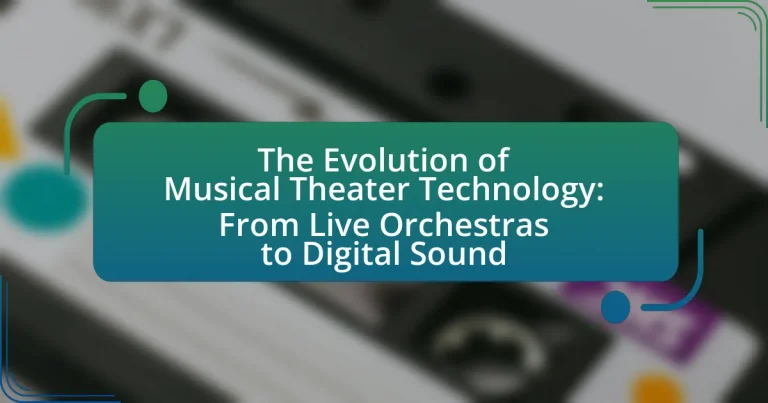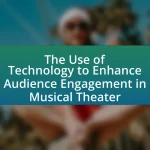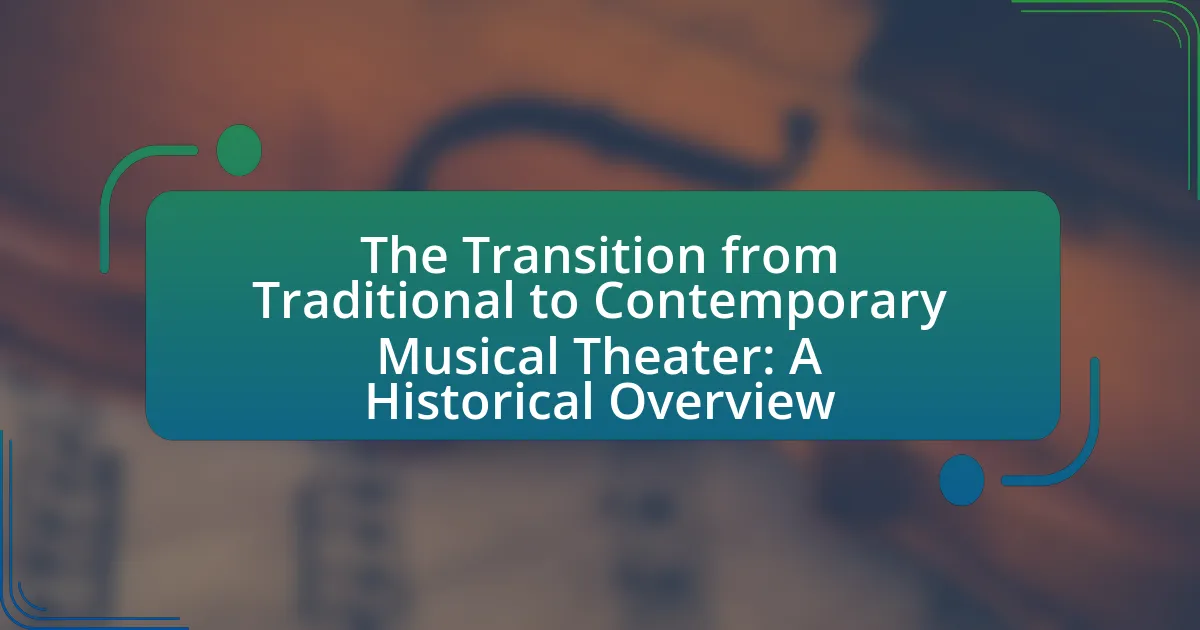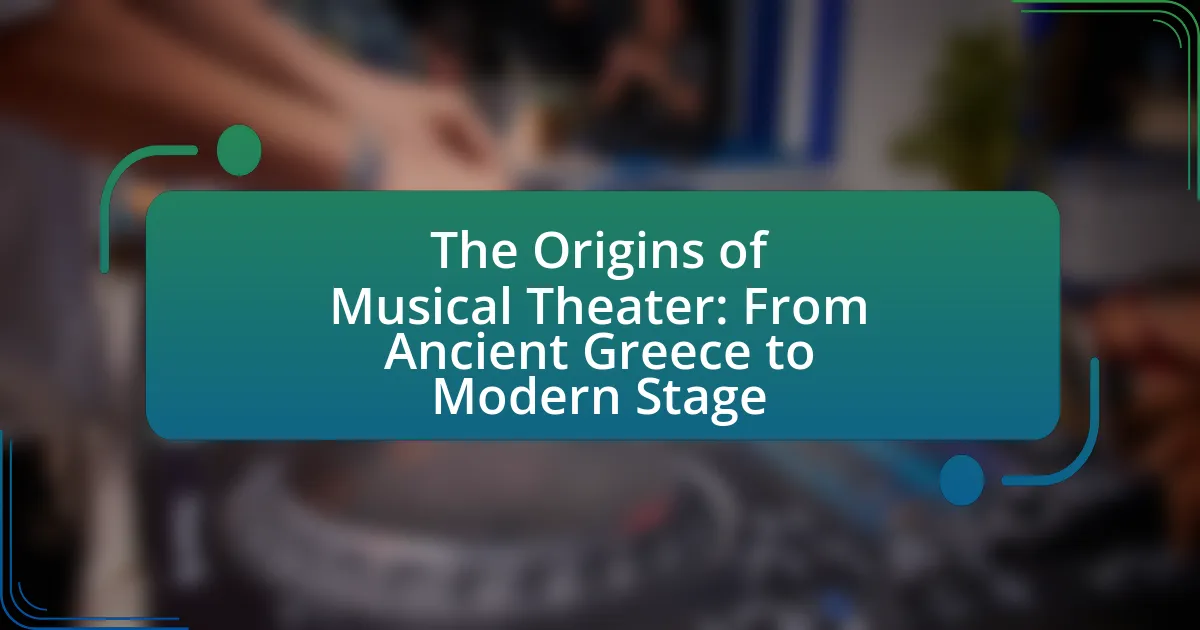The article examines the evolution of musical theater technology, highlighting the transition from live orchestras to advanced digital sound systems. It outlines key milestones such as the introduction of electric lighting, sound amplification, and digital audio technology, which have significantly enhanced production quality and audience engagement. The discussion includes the impact of these technological advancements on sound design, staging, and overall performance, as well as future trends like augmented and virtual reality. Additionally, the article addresses the challenges theaters face in adopting new technologies while balancing tradition with innovation.
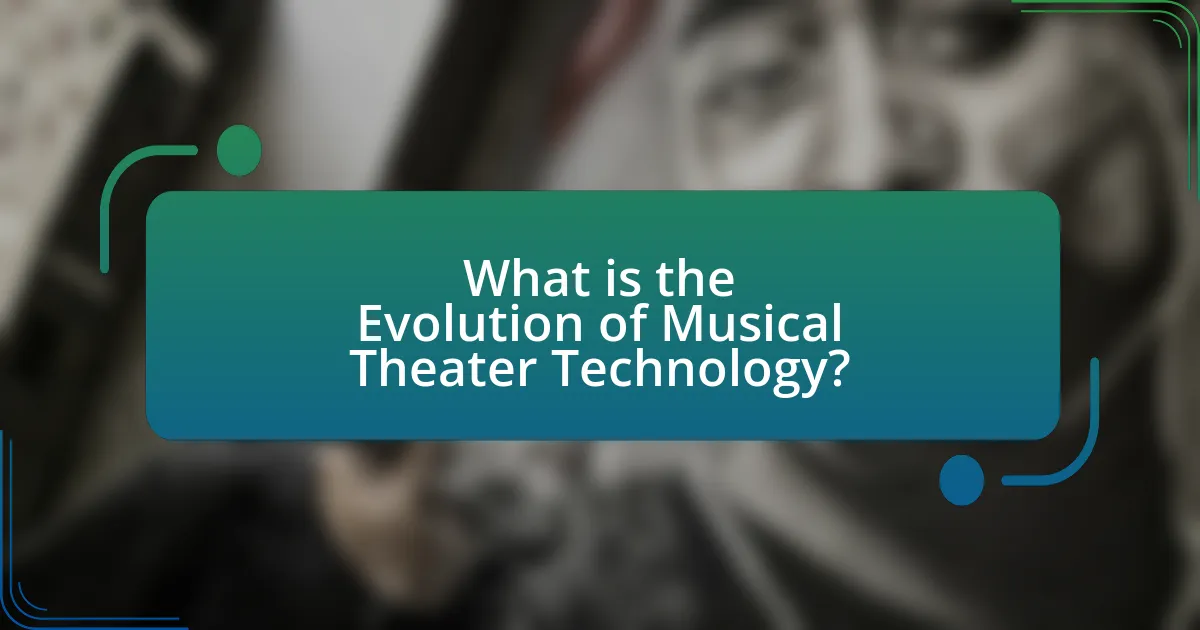
What is the Evolution of Musical Theater Technology?
The evolution of musical theater technology has transitioned from live orchestras to advanced digital sound systems. Initially, musical theater relied on live musicians to accompany performances, creating a unique atmosphere that was integral to the experience. As technology progressed, the introduction of microphones in the 1920s allowed for clearer vocal projection, enhancing audience engagement.
In the mid-20th century, the development of sound amplification systems revolutionized performances, enabling larger venues to accommodate more audiences without sacrificing sound quality. The advent of digital sound technology in the late 20th century further transformed musical theater, allowing for precise sound mixing and effects that could be tailored to each performance.
Today, sophisticated software and hardware enable seamless integration of sound, lighting, and visual effects, creating immersive experiences that were previously unattainable. This progression illustrates how technological advancements have continually shaped the landscape of musical theater, enhancing both production quality and audience enjoyment.
How has musical theater technology changed over time?
Musical theater technology has evolved significantly from the use of live orchestras to the integration of digital sound systems. Initially, productions relied on live musicians to create the score, which limited the complexity and volume of sound. With advancements in technology, the introduction of sound amplification systems in the mid-20th century allowed for clearer and more powerful audio, enabling larger venues to accommodate more extensive orchestral arrangements.
The transition to digital sound in the late 20th century further revolutionized musical theater by allowing for precise sound mixing, effects, and the use of pre-recorded tracks, which enhanced the overall production quality. For instance, the implementation of digital audio workstations and sophisticated sound design software has enabled sound designers to manipulate audio in real-time, creating immersive experiences for audiences. This technological progression has not only improved sound clarity but also expanded the creative possibilities for composers and sound designers in the musical theater landscape.
What were the key milestones in the development of musical theater technology?
Key milestones in the development of musical theater technology include the introduction of electric lighting in the late 19th century, which transformed stage design and visibility. The advent of sound amplification in the early 20th century allowed for clearer vocal performances, significantly enhancing audience experience. The use of recorded music began in the 1920s, enabling orchestras to be replaced or supplemented by pre-recorded tracks, which streamlined productions. The integration of computerized lighting and sound systems in the late 20th century further revolutionized staging, allowing for more complex and dynamic performances. Finally, the rise of digital sound technology in the 21st century has enabled high-quality audio reproduction and innovative sound design, shaping contemporary musical theater.
How did the introduction of electricity impact musical theater?
The introduction of electricity significantly transformed musical theater by enabling the use of electric lighting and sound amplification. Electric lighting allowed for more dynamic stage designs, enhancing visual storytelling through varied lighting effects and colors, which were not possible with gas or candle lighting. Additionally, sound amplification through microphones and speakers improved the clarity and reach of performers’ voices, allowing larger audiences to experience the performance without straining to hear. This technological advancement began in the late 19th century, with electric lights first used in theaters around the 1880s, and by the early 20th century, sound amplification became commonplace, fundamentally changing the production quality and audience engagement in musical theater.
What role did live orchestras play in early musical theater?
Live orchestras were essential in early musical theater, providing the musical foundation that enhanced storytelling and emotional engagement. They accompanied performances, creating a dynamic atmosphere that supported the narrative and character development. The presence of live musicians allowed for real-time interaction with the performers, which contributed to the overall experience of the audience. Historically, orchestras in venues like Broadway and vaudeville houses typically consisted of strings, woodwinds, brass, and percussion, which together produced a rich sound that was integral to the theatrical experience. This orchestral accompaniment was crucial in establishing the musical identity of productions, influencing the evolution of musical theater as a genre.
How did orchestration influence the sound of early musicals?
Orchestration significantly influenced the sound of early musicals by providing a rich, layered musical texture that enhanced storytelling and emotional expression. The use of various instruments allowed composers to create distinct musical themes and motifs that characterized different characters and scenes, thereby deepening the audience’s engagement. For instance, the orchestration in shows like “Show Boat” (1927) utilized a full orchestra to blend jazz influences with traditional musical forms, which helped to establish a new sound that resonated with contemporary audiences. This integration of diverse musical styles through orchestration not only defined the sonic landscape of early musicals but also set the stage for future innovations in musical theater.
What challenges did live orchestras face in theatrical performances?
Live orchestras faced several challenges in theatrical performances, including synchronization issues, logistical constraints, and the need for adaptability to varying performance environments. Synchronization problems arose when coordinating the orchestra with live actors and stage effects, which could lead to timing discrepancies. Logistical constraints included the physical space required for the orchestra, which often limited the staging area for performers and set design. Additionally, orchestras had to adapt to different acoustics in various venues, impacting sound quality and performance dynamics. These challenges highlighted the complexities of integrating live music into theatrical productions, ultimately influencing the shift towards digital sound technologies.
Why is the transition to digital sound significant in musical theater?
The transition to digital sound is significant in musical theater because it enhances audio quality and allows for greater control over sound design. Digital sound technology enables precise mixing, manipulation, and distribution of audio, which improves the overall auditory experience for audiences. For instance, advancements in digital sound systems have led to clearer vocals and more immersive soundscapes, making it possible to integrate complex sound effects and music seamlessly. This shift has been supported by the widespread adoption of digital audio workstations and sound reinforcement systems, which have transformed how sound is produced and delivered in live performances.
What technological advancements facilitated the shift to digital sound?
The technological advancements that facilitated the shift to digital sound include the development of digital audio workstations (DAWs), advancements in digital signal processing (DSP), and the proliferation of compact disc (CD) technology. Digital audio workstations, such as Pro Tools, allowed for precise editing and mixing of sound, revolutionizing how music is produced. Digital signal processing enabled real-time manipulation of audio signals, enhancing sound quality and effects. The introduction of compact discs in the 1980s provided a new medium for high-fidelity sound reproduction, leading to widespread adoption of digital formats. These advancements collectively transformed the landscape of sound production and consumption in musical theater.
How has digital sound changed the audience’s experience of musicals?
Digital sound has significantly enhanced the audience’s experience of musicals by providing clearer audio quality and a more immersive sound environment. This technological advancement allows for precise sound mixing, enabling audiences to hear vocals and instruments with greater clarity and balance, which was often challenging with traditional live orchestras. For instance, the use of digital sound systems can amplify softer voices and blend various sound elements seamlessly, creating a richer auditory experience. Additionally, digital sound facilitates innovative sound design, allowing for the incorporation of sound effects and recorded music that can enhance storytelling and emotional impact, as seen in productions like “Hamilton,” where sound design plays a crucial role in the overall experience.

What are the key technologies in modern musical theater?
Key technologies in modern musical theater include digital sound systems, automated lighting, and projection mapping. Digital sound systems enhance audio quality and allow for complex soundscapes, enabling clear vocal and instrumental performances. Automated lighting technology provides dynamic visual effects and precise control over stage illumination, enhancing the storytelling aspect of productions. Projection mapping allows for immersive set designs by projecting images onto surfaces, creating versatile and engaging environments. These technologies collectively transform the audience experience and expand the creative possibilities for theater productions.
How do sound design and mixing contribute to a musical’s success?
Sound design and mixing are critical to a musical’s success as they enhance the overall auditory experience, ensuring clarity and emotional impact. Effective sound design creates an immersive environment by integrating music, dialogue, and sound effects, which helps convey the story and emotions of the characters. For instance, a well-mixed score allows the audience to hear lyrics clearly while maintaining the musical’s dynamic range, which is essential for engagement. Historical evidence shows that advancements in sound technology, such as the introduction of digital mixing consoles, have significantly improved sound quality in live performances, leading to greater audience satisfaction and critical acclaim.
What tools are commonly used in sound design for musicals?
Common tools used in sound design for musicals include digital audio workstations (DAWs), microphones, speakers, and sound mixing consoles. Digital audio workstations, such as Pro Tools and Logic Pro, allow sound designers to create, edit, and mix audio tracks efficiently. Microphones capture live performances, while speakers distribute sound to the audience. Sound mixing consoles enable sound engineers to control audio levels and effects during performances. These tools have evolved significantly, transitioning from traditional live orchestras to sophisticated digital systems, enhancing the overall auditory experience in musical theater.
How does sound mixing enhance the overall production quality?
Sound mixing enhances overall production quality by balancing and blending various audio elements to create a cohesive auditory experience. This process allows for the precise adjustment of levels, equalization, and effects, ensuring that dialogue, music, and sound effects are clear and well-integrated. For instance, in musical theater, effective sound mixing can elevate performances by ensuring that vocalists are heard distinctly over orchestral arrangements, which is crucial for audience engagement and comprehension. Studies have shown that productions with high-quality sound mixing receive better audience ratings and reviews, highlighting its impact on the overall perception of the performance.
What impact do digital instruments have on musical performances?
Digital instruments significantly enhance musical performances by providing versatility, precision, and accessibility. They allow musicians to create a wide range of sounds and effects that traditional instruments cannot produce, enabling innovative compositions and arrangements. For instance, synthesizers can replicate orchestral sounds or create entirely new audio textures, expanding the creative possibilities for composers and performers. Additionally, digital instruments often include features such as MIDI connectivity, which facilitates seamless integration with other digital audio workstations, enhancing live performance capabilities. The use of digital technology in performances has been shown to attract larger audiences, as evidenced by the rise of electronic music festivals, which have grown in popularity over the past two decades, indicating a shift in audience preferences towards digitally enhanced musical experiences.
How do digital instruments compare to traditional orchestral instruments?
Digital instruments offer greater versatility and accessibility compared to traditional orchestral instruments. While traditional instruments require extensive training and physical presence, digital instruments can be played by anyone with basic knowledge and can replicate a wide range of sounds and styles, making them more adaptable for various musical genres. Additionally, digital instruments often come with built-in effects and editing capabilities, allowing for real-time manipulation of sound, which is not possible with acoustic instruments. This adaptability is supported by the rise of music production software, which has transformed how music is created and performed, enabling composers to produce complex arrangements without the need for a full orchestra.
What are the benefits of using digital instruments in live performances?
The benefits of using digital instruments in live performances include enhanced sound quality, versatility, and ease of integration with other technologies. Digital instruments provide superior audio fidelity compared to traditional acoustic instruments, allowing for a clearer and more polished sound. Additionally, they offer a wide range of sounds and effects, enabling performers to explore diverse musical styles and create unique soundscapes. The integration of digital instruments with software and hardware systems facilitates seamless collaboration with lighting and visual effects, enhancing the overall production value. Furthermore, digital instruments often require less physical space and can be more easily transported, making them practical for various performance settings.
How has technology influenced the staging and production of musicals?
Technology has significantly influenced the staging and production of musicals by enhancing sound quality, visual effects, and overall audience engagement. The introduction of digital sound systems has allowed for clearer audio and the ability to balance live performances with pre-recorded tracks, improving the listening experience. Additionally, advancements in lighting technology, such as LED fixtures and automated lighting, have enabled more dynamic and visually stunning stage designs, allowing for greater creativity in storytelling. Furthermore, projection mapping technology has transformed set design by allowing for immersive backgrounds and effects that can change in real-time, enhancing the narrative without the need for physical set changes. These technological innovations have collectively elevated the production value of musicals, making them more appealing to contemporary audiences.
What role does lighting technology play in modern musical theater?
Lighting technology plays a crucial role in modern musical theater by enhancing storytelling and creating immersive experiences for the audience. It allows for dynamic scene changes, mood setting, and character highlighting, which are essential for conveying emotions and themes. Advanced lighting systems, such as LED fixtures and automated lighting, enable precise control over color, intensity, and movement, facilitating complex visual effects that complement the narrative. For instance, the use of programmable lighting in productions like “Hamilton” has demonstrated how lighting can significantly impact the audience’s perception and engagement, making it an integral component of contemporary theatrical performances.
How do projection and multimedia elements enhance storytelling?
Projection and multimedia elements enhance storytelling by providing visual context and emotional depth that traditional methods cannot achieve. These technologies allow for dynamic backgrounds, animations, and real-time effects that can transform a stage into various settings, thereby immersing the audience in the narrative. For instance, the use of projections in productions like “The Lion King” creates a vibrant atmosphere that complements the story, making scenes more engaging and impactful. Studies have shown that integrating multimedia elements can increase audience retention and emotional response, as they stimulate multiple senses simultaneously, reinforcing the narrative and character development.
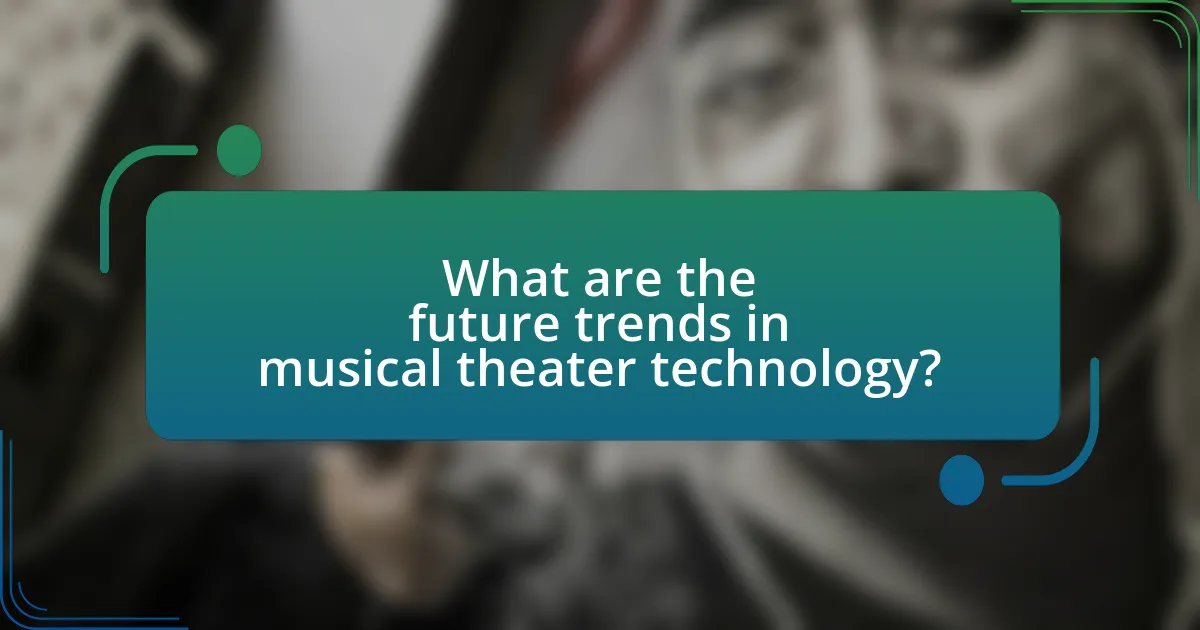
What are the future trends in musical theater technology?
Future trends in musical theater technology include the integration of augmented reality (AR) and virtual reality (VR) to enhance audience engagement and storytelling. These technologies allow for immersive experiences, enabling audiences to interact with the performance in real-time. Additionally, advancements in sound design, such as spatial audio and 3D soundscapes, are becoming more prevalent, providing a richer auditory experience. The use of artificial intelligence (AI) in scriptwriting and music composition is also on the rise, allowing for more dynamic and personalized performances. These trends reflect a shift towards more interactive and technologically advanced productions, as evidenced by recent successful implementations in major theater productions worldwide.
How might virtual reality and augmented reality shape future productions?
Virtual reality (VR) and augmented reality (AR) will significantly shape future productions by enhancing audience engagement and creating immersive experiences. These technologies allow for interactive storytelling, where viewers can participate in the narrative, thus transforming traditional passive viewing into an active experience. For instance, VR can transport audiences into the performance space, enabling them to explore the environment and interact with characters, while AR can overlay digital elements onto live performances, enriching the visual storytelling. Research indicates that productions utilizing VR and AR can increase audience retention and emotional connection, as evidenced by the success of shows like “The Lion King” in AR formats, which have demonstrated higher audience satisfaction rates.
What are the potential benefits of incorporating VR and AR in musicals?
Incorporating VR and AR in musicals can enhance audience engagement and create immersive experiences. These technologies allow for interactive storytelling, enabling viewers to feel part of the performance rather than mere spectators. For instance, a study by the University of Southern California found that immersive experiences can increase emotional connection and retention of the narrative, leading to a more impactful experience. Additionally, VR and AR can facilitate innovative stage designs and visual effects that traditional methods cannot achieve, broadening the creative possibilities for directors and designers. This integration can also attract a younger audience familiar with digital technologies, thereby revitalizing interest in musical theater.
How can these technologies create immersive experiences for audiences?
Technologies such as augmented reality (AR), virtual reality (VR), and advanced sound systems create immersive experiences for audiences by enhancing sensory engagement and interaction. AR overlays digital elements onto the physical world, allowing audiences to experience performances in a more interactive manner, while VR transports them into entirely virtual environments, making them feel as if they are part of the story. Advanced sound systems, including spatial audio, provide a three-dimensional auditory experience that enhances emotional connection and realism. For instance, a study by the University of Southern California found that immersive soundscapes can significantly increase audience emotional responses, leading to a more profound engagement with the performance.
What challenges do theaters face in adopting new technologies?
Theaters face significant challenges in adopting new technologies, primarily due to financial constraints, technical expertise, and audience adaptation. Financially, many theaters operate on tight budgets, making it difficult to invest in expensive new equipment or training. For instance, a survey by the Theatre Communications Group found that 60% of theaters reported budget limitations as a barrier to technology upgrades. Additionally, the lack of technical expertise among staff can hinder the effective implementation of new systems, as many theaters rely on a small team with limited training in advanced technologies. Finally, audience adaptation poses a challenge; some patrons may resist changes in traditional formats, impacting ticket sales and overall acceptance of new technological experiences.
How can theaters balance tradition with technological innovation?
Theaters can balance tradition with technological innovation by integrating modern technology while preserving classic performance elements. For instance, many theaters now utilize digital sound systems to enhance audio quality without replacing live orchestras, which remain integral to the theatrical experience. This approach allows for improved sound clarity and effects, as evidenced by the use of advanced sound mixing techniques in productions like “Hamilton,” which combines traditional musical elements with contemporary technology. Additionally, theaters can employ projection mapping to create immersive environments that complement live performances, thereby enriching the audience’s experience while maintaining the essence of live theater. This balance ensures that the artistry of traditional performances is not lost but rather enhanced through thoughtful technological integration.
What are the financial implications of upgrading technology in productions?
Upgrading technology in productions has significant financial implications, primarily involving initial capital investment, operational cost savings, and potential revenue increases. The initial capital investment can be substantial, as new technology often requires purchasing advanced equipment and software, which can range from thousands to millions of dollars depending on the scale of the production. However, operational cost savings can be realized through increased efficiency and reduced labor costs; for instance, automated lighting and sound systems can lower the need for extensive crew members, leading to long-term savings. Additionally, upgraded technology can enhance the audience experience, potentially increasing ticket sales and revenue; a study by the National Endowment for the Arts found that productions utilizing advanced sound and lighting technology saw a 20% increase in attendance. Thus, while the upfront costs are high, the long-term financial benefits can outweigh these initial expenditures.
What best practices should theaters follow when integrating new technologies?
The best practices theaters should follow when integrating new technologies include conducting thorough research on the technology’s impact on performances, training staff adequately, and ensuring compatibility with existing systems. Researching the technology helps theaters understand its benefits and limitations, which is crucial for enhancing audience experience and operational efficiency. Adequate staff training ensures that personnel can effectively utilize new tools, minimizing disruptions during performances. Additionally, ensuring compatibility with existing systems prevents technical issues that could detract from the overall production quality. These practices are supported by industry standards, such as the American Theatre Wing’s guidelines, which emphasize the importance of technology integration in enhancing theatrical experiences.
